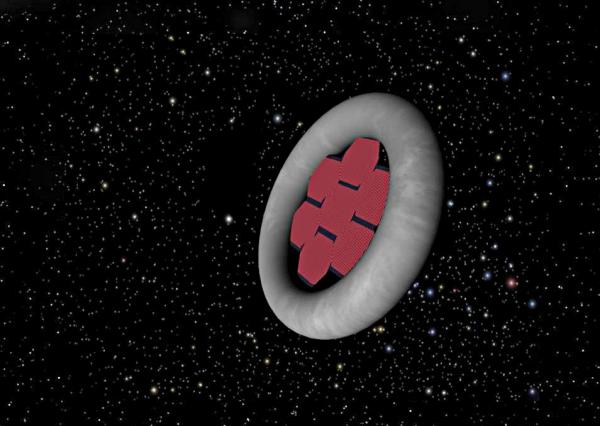BY LETTER
Conway's World
Megastructure of unknown terragen origin that displays a simple cellular automation cycle. | |
 Image from Steve Bowers | |
| The minute black and white tiles of Conway's world appear grey from a distance, although slowly fluctuating patches of variant hue are visible | |
In late 8327 a routine stellar survey program detected a planet orbiting in an uninhabited star system. A number of anomalies were immediately apparent: despite being too small for a gas giant, the planet's density was far lower than that of any known terrestrial world. Although at the time no plans to explore the system had been made, it was flagged "interesting" by the project's overseeing AI and left for future expeditions to follow up on.
In 8563 a research probe first entered the system. It discovered that the object was not a planet but a huge toroidal artifact, nearly 16,200 kilometers in diameter and massing about 14% as much as the Earth. Composed primarily of diamondoid, the object is orbited by a cloud of nanofoglets and laser batteries which actively prevent micrometeorite impacts. A hexagonal array of solar collectors in the "hole" of the torus provide power to the structure. The torus rotates, apparently to reduce structural strains due to its self-gravitation; a tangential velocity of 2.66 kilometers per second exactly cancels the gravity at the outer edge of the object.
The probe recorded the artifact's large-scale properties, but it was not until the first crewed expedition to the system that its most remarkable property was discovered. The surface of the torus consists of a layer of pure diamond one meter thick. Half a meter beneath the surface of this protective skin lie a vast number of microscopic squares, averaging less than 0.2 microns on a side, which seamlessly tile the entire surface of the torus. The cells' outer surfaces are composed of a substance that can switch between being black and white upon receiving an electrical signal from the nanoprocessor located underneath.
Seventeen times a second the entire field of cells "cycles", changing the pattern displayed according to rules formulated by a twentieth-century Earth mathematician for whom the object is now named. A black cell with exactly three white neighbors becomes a white cell; a white cell with either two or three white neighbors remains white; otherwise the cell becomes or remains black. A computronium node at the torus's center emits pulses along optical fibers, which act to synchronize the timing of the cycles. Over time, these simple rules have given rise to fantastically complex patterns. Close study has revealed that a simple form of life even exists in the abstract universe represented by the cells, able to grow, reproduce, repair itself and respond to simple stimuli. Unfortunately, the granular and two-dimensional nature of this universe makes the development of higher forms of life or intelligence highly unlikely.
Image from Steve Bowers | |
| A small section of the surface of Conway's world, showing the Game in progress | |
Appears in Topics
Development Notes
Text by Xaonon
Initially published on 09 November 2003.
Initially published on 09 November 2003.






